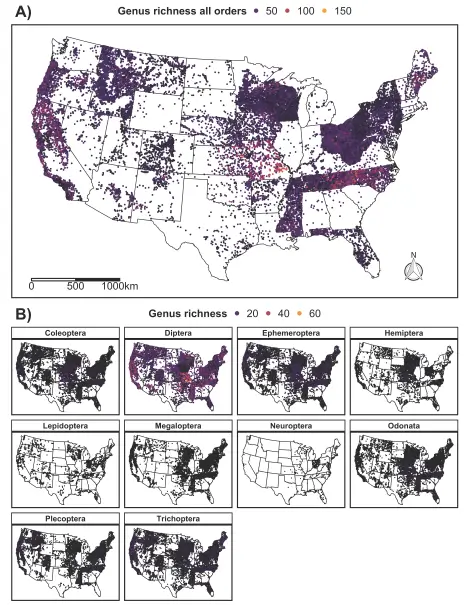Featured Data
Freshwater Insect Occurrences and Traits for the Contiguous United States, 2001 – 2018
March 1, 2021
Susanne Grossman-Clarke
Citation
Twardochleb, L.A., E. Hiltner, M. Pyne, P. Bills, and P.L. Zarnetske. 2020. Freshwater insect occurrences and traits for the contiguous United States, 2001 – 2018 ver 5. Environmental Data Initiative. https://doi.org/10.6073/pasta/8238ea9bc15840844b3a023b6b6ed158.
Description
This featured data package relates to a recent data paper in Global Ecology and Biogeography, describing a database of freshwater insect occurrences and traits for the contiguous United States (Twardochleb et al. 2021). The lead author, Laura Twardochleb, is a senior environmental scientist with the California Department of Water Resources.

Freshwater insects comprise 60% of the diversity of freshwater animals and are essential indicators of ecosystem health. Yet our knowledge of the distribution of freshwater insect diversity in the United States is incomplete because we lack comprehensive data on freshwater insect distributions and traits at a continental scale. Under Laura’s lead, this knowledge gap was filled by compiling and publishing a database of occurrence records and functional traits for freshwater insects in the contiguous US and presenting the database in the above mentioned data publication. The database can be used to map freshwater insect taxonomic and functional diversity, and when paired with environmental data, will provide a powerful resource for quantifying how the environment shapes diversity patterns as well as taxon-specific distributions across the continguous US.
The authors compiled over 2.05 million genus occurrence records for 932 genera in the major freshwater insect orders, at 51,044 stream locations sampled between 2001 and 2018 by federal and state biological monitoring programs.

Compared with existing open‐access databases, the authors tripled the number of occurrence records and locations and added records for 118 genera, nearly doubled the number of traits for 11 trait groups and added traits for 180 genera that were not available from open‐access databases. In the database, information is assembled on life history, dispersal, morphology, and ecology traits from existing databases, scientific books, and the primary literature, and present traits and trait affinities for 1,072 insect genera. The database contains georeferenced occurrence records and traits for stream insects a grain of about 1 square meter. The temporal resolution is daily. The major taxa and level of measurement are: Genera from the orders Coleoptera, Diptera, Ephemeroptera, Hemiptera, Lepidoptera, Megaloptera, Neuroptera, Odonata, Plecoptera and Trichoptera. The figure (left) presents the freshwater insect genus richness by occurrence location for all (a) and individual (b) insect orders across the continental United States.
Data sources for the database include:
- U.S. Environmental Protection Agency (USEPA) Freshwater Biological Traits database and the Water Quality Portal, including trait information, habitat, life‐history, mobility, morphological and ecological trait data for 1,343 North American macroinvertebrate genera, including freshwater insects, molluscs and arachnids.
- Unpublished trait data compiled in 2014 for a Californian project on stream hydrology (Mazor et al., 2016; Stein et al., 2017). For a list of sources, see Apendix A of Twardochleb et al. (2021).
- Peer‐reviewed papers containing information on the ecology of freshwater insects with referenced papers from 1911 to 2018.
References
Twardochleb, L, Hiltner, E, Pyne, M, Zarnetske, P. Freshwater insects CONUS: A database of freshwater insect occurrences and traits for the contiguous United States. Global Ecol Biogeogr. 2021; 00: 1– 16. https://doi.org/10.1111/geb.13257
Mazor, R. D., Rehn, A. C., Ode, P. R., Engeln, M., Schiff, K. C., Stein, E. D., Gillett, D. J., Herbst, D. B., & Hawkins, C. P. (2016). Bioassessment in complex environments: Designing an index for consistent meaning in different settings. Freshwater Science, 35, 249–271. https://doi.org/10.1086/684130
Stein, E. D., Sengupta, A., Mazor, R. D., McCune, K., Bledsoe, B. P., McCune, K., & Adams, S. (2017). Application of regional flow‐ecology relationships to inform watershed management decisions: Application of the ELOHA framework in the San Diego River watershed, California, USA. Ecohydrology, 10, e1869. https://doi.org/10.1002/eco.1869